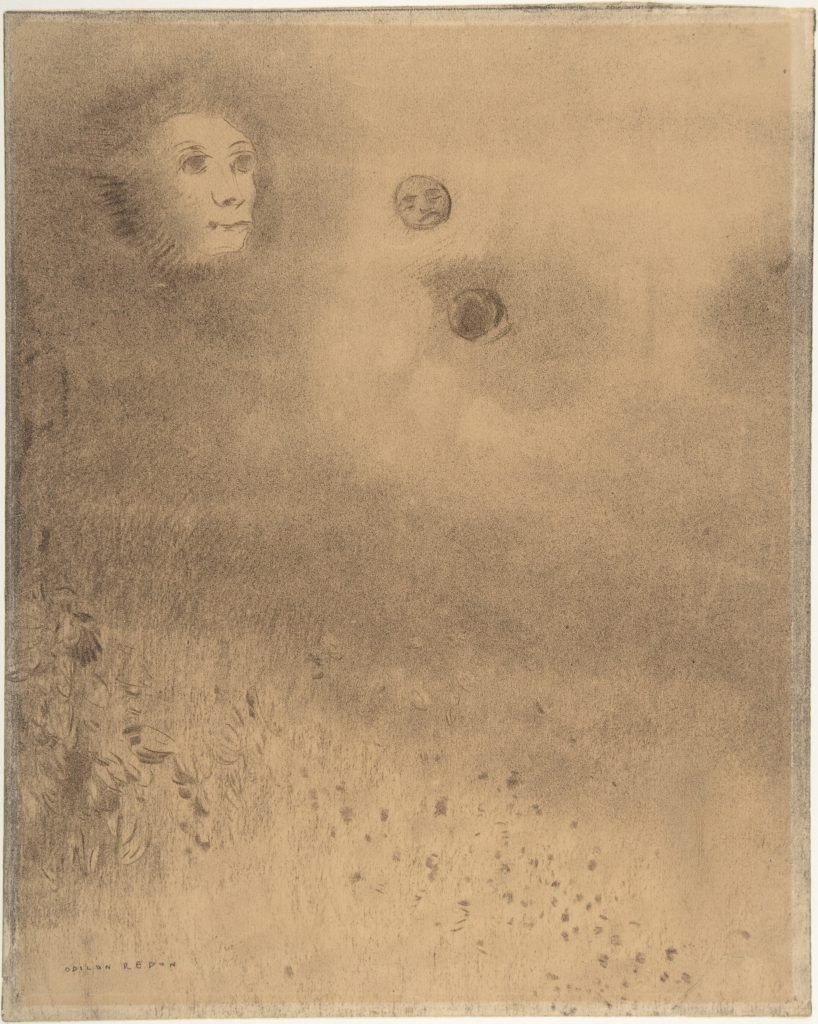11.2 Psychosis and Delirium
Psychosis
Approximately 3 percent of the people in the United States experience psychosis at some point in their lives. About 100,000 adolescents and young adults in the US experience their first episode of psychosis each year.[1]
Psychosis is a broad term that refers to a symptom complex characterized by hallucinations, delusions, and disorganized thinking. It can occur in various psychiatric and medical conditions, including schizophrenia, mood disorders, and substance-induced states. Symptoms of psychosis include delusions and hallucinations, where the client is seeing, hearing, or experiencing other sensations and experiences that aren’t real. See Figure 11.1.[2] for artwork titled Hallucinations. Other symptoms of psychosis include incoherent or nonsensical speech and behavior that is inappropriate for the situation. A psychotic episode is a specific, time-limited occurrence of psychotic symptoms. It can be a single event or part of a recurring pattern, such as in first-episode psychosis. A person experiencing a psychotic episode may also experience depression, anxiety, sleep problems, social withdrawal, lack of motivation, and overall difficulty functioning. When someone experiences this condition, it is referred to as a psychotic episode.[3]

Psychosis can be a symptom of various mental illnesses, such as schizophrenia, bipolar disorder, severe depression, or severe anxiety, but there are also other potential causes. Sleep deprivation, medical conditions such as hyperglycemia and hyperthyroidism, side effects of some prescription medications, and use of alcohol or other drugs can also cause psychotic symptoms.[4] See Table 11.2 for a side-by-side comparison of psychosis and psychotic episode.
Table 11.2. Comparison of Psychosis and Psychotic Episode[5],[6]
| Aspect | Psychosis | Psychotic Episode |
|---|---|---|
| Definition | A mental condition characterized by a disconnection from reality. | A specific period during which symptoms of psychosis are actively experienced. |
| Nature | Ongoing or recurring condition; can be chronic or part of another disorder. | Acute, time-limited occurrence of psychotic symptoms. |
| Symptoms | Delusions, hallucinations, disorganized thinking, impaired insight. | Same symptoms as psychosis, but experienced intensely in a short time frame. |
| Duration | Can last weeks, months, or be lifelong (depending on cause). | Usually lasts hours to weeks; typically sudden onset. |
| Cause | May be due to mental illness (e.g., schizophrenia), substance use, trauma, or medical conditions. | Triggered by stress, drug use, sleep deprivation, or illness. |
| Diagnosis | Used to describe a condition that may be part of disorders like schizophrenia or bipolar disorder. | Not a diagnosis itself but rather an event within a broader diagnosis. |
| Treatment Approach | Long-term management with antipsychotics, therapy, and support. | Immediate intervention with medications, hospitalization if needed. |
| Prognosis | Varies by cause; some recover fully, but others may have recurring episodes. | May resolve completely or indicate the beginning of a chronic condition. |
| Common Misconception | Often confused with violence or multiple personality disorder. | Thought to be a “one-time” event, but may signal a larger issue. |
Early Signs of Psychosis
Typically, a person will show changes in their behavior before psychosis develops. Behavioral warning signs for psychosis include the following[7]:
- Drop in grades or worsening job performance
- New trouble thinking clearly or concentrating
- Suspiciousness; paranoid ideas or uneasiness with others
- Withdrawing socially; spending a lot more time alone than usual
- Unusual, bizarre new ideas
- Strange feelings or having no feelings at all
- Decline in self-care or personal hygiene
- Difficulty telling reality from fantasy
- Confused speech or trouble communicating
Symptoms of a Psychotic Episode
See the following box for signs and symptoms of a psychotic episode according to the Diagnostic and Statistical Manual of Mental Disorders (DSM–5-TR) by the American Psychiatric Association.
DSM-5-TR Symptoms of a Brief Psychotic Episode[8]
- Delusions
- Hallucinations
- Disorganized speech (e.g., frequent derailment or incoherence)
- Grossly disorganized or catatonic behavior (i.e., a pronounced increase or decrease in the rate and amount of movement; purposeless excessive movement)
A brief psychotic episode is defined by a psychotic event lasting at least one day but less than one month, with an eventual return to previous level of functioning. It does not include a culturally sanctioned response, such as a person’s response to the death of a loved one. The disturbance is not better explained by a major depressive disorder or bipolar disorder with psychotic features, another psychotic disorder, or the physiological effects of a substance or a medical condition. The mental health provider may specify if the symptoms are in response to significant stressors (i.e., significant events to anyone experiencing similar circumstances in the individual’s culture) or has a peripartum onset (i.e., during pregnancy or within four weeks of delivery).[9]
Review information about delusions, hallucinations, and disorganized speech in the “Application of the Nursing Process in Mental Health Care” chapter.
Treatment of Psychosis
Treating psychosis involves a comprehensive, long-term approach tailored to the underlying cause of the condition. For example, if psychosis is caused by a medical condition, side effects of medication, or withdrawal from a substance, it will resolve as these conditions are treated. If psychosis is a symptom of mental illness, treatment typically includes a combination of antipsychotic medicines and psychological therapies. The cornerstone of treatment is antipsychotic medication, which helps reduce or eliminate symptoms like hallucinations and delusions. These medications may be used long-term to prevent relapse, especially in chronic conditions such as schizophrenia. In addition to medication, individuals benefit from psychosocial interventions, including cognitive-behavioral therapy (CBT), which helps manage thought patterns and improve insight. Supportive services like case management, peer support, and vocational rehabilitation can also enhance recovery and quality of life. Family education is often included to promote a supportive environment. Treatment plans are individualized and often involve a multidisciplinary team including psychiatrists, nurses, social workers, and therapists. Read more about the treatment of psychosis associated with schizophrenia in the “Schizophrenia” section of this chapter.
A psychotic episode is typically treated as a medical emergency, especially if the person is at risk of harming themselves or others. The immediate goal is to stabilize the individual and reduce acute symptoms. Treatment usually begins with antipsychotic medication, often administered in a hospital or closely monitored outpatient setting. Short-term use of sedatives may be considered to manage agitation or insomnia. Once stabilized, care may transition to outpatient follow-up with a psychiatrist or mental health team. Identifying and addressing triggers such as stress, substance use, or underlying medical issues is essential to prevent future episodes. Education and early intervention following a first episode can significantly improve long-term outcomes, and clients are often referred to specialized early psychosis intervention programs when available.
Delirium
Psychosis caused by medical issues is often referred to as delirium. Delirium is a mental state in which the client becomes temporarily confused, disoriented, and not able to think or remember clearly. It usually starts suddenly and can indicate the onset of a life-threatening medical condition. Delirium resolves as the underlying condition is effectively treated. There are many common causes of delirium, including the following[10],[11]:
- Dehydration and electrolyte imbalances
- Dementia
- Hospitalization, especially in intensive care
- Intoxication or withdrawal from alcohol or drugs
- Kidney or liver failure
- Medications, such as sedatives, opioids, anesthesia, antihistamines, anticholinergics, antidepressants, antipsychotics, or anticonvulsants
- Metabolic disorders, such as diabetic ketoacidosis (DKA)
- Serious infections, such as urinary tract infections, pneumonia, and influenza
- Severe pain
- Sleep deprivation
Advanced age makes individuals more vulnerable to delirium, especially when faced with illness or medical stress.[12]
The symptoms of delirium usually start suddenly, over a few hours or a few days, and they often come and go. The most common symptoms are as follows[13]:
- Changes in alertness (usually more alert in the morning, less at night)
- Changing levels of consciousness
- Confusion
- Disorganized thinking or talking in a way that doesn’t make sense
- Disrupted sleep patterns or sleepiness
- Emotional changes: anger, agitation, depression, irritability, or overexcitement
- Hallucinations and delusions
- Incontinence
- Memory problems, especially with short-term memory
- Trouble concentrating
Treatment depends on identifying and treating underlying causes. The symptoms of delirium can often be managed with the following interventions[14]:
- Making sure the room is quiet and well-lit
- Having clocks and calendars within view
- Inviting family members to spend time in the room
- Ensuring hearing aids and glasses are worn
- Allowing for undisrupted sleep when possible
- Getting clients up and out of bed when possible
- Encourage calorie intake and hydration
- Controlling pain with pain relievers (unless the pain medication is causing the psychosis)
- Administering prescribed medications to distressed clients at risk to themselves or to others to calm and settle them, such as haloperidol (However, administer medications with caution because oversedation can worsen delirium.)
- Avoiding the use of restraints
View the Confusion Assessment Method (CAM) PDF commonly used to detect delirium.
View the following YouTube video on managing delirium[15]: Managing Delirium Out of Hours.
- National Institute of Mental Health. (n.d.). What is psychosis? U.S. Department of Health and Human Services. https://www.nimh.nih.gov/health/topics/schizophrenia/raise/what-is-psychosis ↵
- “Hallucinations_MET_DP808068.jpg” by Odilon Redon is in the Public Domain. ↵
- National Institute of Mental Health. (n.d.). What is psychosis? U.S. Department of Health and Human Services. https://www.nimh.nih.gov/health/topics/schizophrenia/raise/what-is-psychosis ↵
- National Institute of Mental Health. (n.d.). What is psychosis? U.S. Department of Health and Human Services. https://www.nimh.nih.gov/health/topics/schizophrenia/raise/what-is-psychosis ↵
- Liberman, J. A., & Frist, M. B. (2018). Psychotic disorders. The New England Journal of Medicine, 379(3), 270-280 doi: 10.1056/NEJMra1801490 ↵
- Fusar-Poli, P., Salazar de Pablo, G., Rajkumar, R. P., López-Díaz, Á., Malhotra, S., Heckers, S., Lawrie, S. M., & Pillmann, F. (2022). Diagnosis, prognosis, and treatment of brief psychotic episodes: A review and research agenda. Lancet Psychiatry, 9(1), 72-83. doi: 10.1016/S2215-0366(21)00121-8. ↵
- National Institute of Mental Health. (n.d.). What is psychosis? U.S. Department of Health and Human Services. https://www.nimh.nih.gov/health/topics/schizophrenia/raise/what-is-psychosis ↵
- American Psychiatric Association. (2022). Desk reference to the diagnostic criteria from DSM-5-TR (5th ed.). American Psychiatric Association Publishing ↵
- American Psychiatric Association. (2022). Desk reference to the diagnostic criteria from DSM-5-TR (5th ed.). American Psychiatric Association Publishing. ↵
- MedlinePlus. (2023). Delirium. https://medlineplus.gov/delirium.html ↵
- American Delirium Society. (n.d.). About delirium. https://americandeliriumsociety.org/ ↵
- Marcantonio, E. R. (2017). Delirium in hospitalized older adults. The New England Journal of Medicine, 377(15), 1456-1466. doi: 10.1056/NEJMcp1605501 ↵
- MedlinePlus. (2023). Delirium. https://medlineplus.gov/delirium.html ↵
- MedlinePlus. (2023). Delirium. https://medlineplus.gov/delirium.html ↵
- Association for Elderly Medicine Education. (2014, February 6). Managing delirium out of hours [Video]. YouTube. All rights reserved. https://youtu.be/1iKe-6lc5b0 ↵
Conditions where there is a loss of contact with reality.
Fixed, false belief not held by cultural peers and persisting in the face of objective contradictory evidence.
False sensory perceptions not associated with real external stimuli that can include any of the five senses (auditory, visual, gustatory, olfactory and tactile).
A specific, time-limited occurrence of psychotic symptoms.
An onset of an abnormal mental state, often with fluctuating levels of consciousness, disorientation, irritability, and hallucinations.

